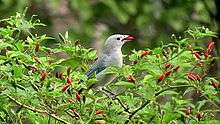Malagueta pepper
Malagueta pepper (Portuguese pronunciation: [mɐlɐˈɣeːtɐ]), a variety of Capsicum frutescens,[1] is a type of chili pepper widely used in Brazil, the Caribbean, Portugal, Mozambique, Angola, and São Tomé and Príncipe. It is heavily used in the Bahia state of Brazil. It apparently got its name from the unrelated melegueta pepper (a seed-derived spice) from West Africa, because of a similar level of piquancy (spiciness or hotness of flavor).
| Malagueta pepper | |
|---|---|
 A sayaca tanager feeding on malagueta peppers | |
| Genus | Capsicum |
| Species | Capsicum frutescens |
| Cultivar | 'Malagueta' |
| Heat | |
| Scoville scale | 60,000–100,000 SHU |
It is a small, tapered chil that rates at about 5 cm (2 in) in length. It has a range of 60,000 to 100,000 Scoville units. Two sizes are seen in markets, which sometimes have different names: the smaller ones are called malaguetinha in Brazil, and as piri piri (a Swahili name) in Mozambique and in Portugal, though this name is now also used for a newer, derived African cultivar, the piri piri pepper), while the larger ones are called malagueta in both Brazil and Portugal. They are not different varieties, just peppers of different maturities from the same plant. In Portugal, it is sometimes simply referred to as pimenta or chili, though other varieties are available in modern markets today. It is also known in Angola by the names of jindungo, ndongo, nedungo, and pripíri in various local languages. In Cape Verde, malagueta is called malgueta and margueta in the Criola language.
History
The first Europeans to have contact with this species were the crew members who accompanied Christopher Columbus when they first landed in the Caribbean in 1492. In addition to being a noble delicacy much appreciated by the ancient inhabitants of the Americas, it was also used as a natural dye and, above all, as a medicine.
The spicy capsaicin content of the chilis must have aroused the interest of the Portuguese, who for decades have been looking for easier sources for the then-rare black pepper of Asia (the piquant compound in which is piperine); one of the major motivations for the Columbian voyages was to discover a new route to Asia for direct trade in spices, silks, and other Asian goods. At the time of Columbus's arrival in the New World, the Portuguese traded from the Gulf of Guinea a very popular African spice as a substitute for the black pepper: Aframomum melegueta (today in disuse in the West, but known as grains of paradise), which was then best known as melegueta pepper. The name was applied to the local chilis, as malagueta, because the chili's piquancy was reminiscent of Old World pepper.[2] (Today, various botanical and culinary writers continue to confuse malagueta chilis and melegueta pepper.)
In the period of intense exchanges and trips, named today the Columbian exchange, between Europe and the Americas, Portuguese navigators took this new "malagueta" to Portugal and to Brazil, where it became known as chili, chile, or pimenta; to Africa where it became very popular as jindungo and piri-piri; and eventually took it to Asia, where it became an ingredient of curries and other spicy dishes. Less than a century after being brought to Europe, chili pepper, because of its qualities, spread to many other Old World cultures, including Arabia, India, Thailand, China, and surrounding regions, integrating with local cuisines.
Uses in food and cooking
This pepper is used to season many regional dishes and sauces in Brazil and Mozambique. In Portugal, it is mainly used to season poultry dishes.
In Brazil, what is now being sold as malagueta may well be a recent hybrid, while what is now referred to as malaguetinha, malagueta silvestre, malagueta caipira may well be the original malagueta, and was actually the only malagueta on the market 30 years ago. While there have been claims that cumarim, cumari, and pimenta cumarim are other names for malagueta, these are quite different and they appear to belong in the Capsicum chinense species.
In the cuisine of São Tomé and Príncipe, piri-piri sauce made with malagueta peppers is commonly available as a condiment in restaurants throughout São Tomé and Príncipe, as well as in Portugal.[3]
In the Dominican Republic, malagueta with allspice to make a preparation called pimenta dioica.
In popular culture
Malagueta chilis were featured in Woman on Top, a 2000 American fantasy and romantic comedy film directed by Fina Torres and starring Penélope Cruz, in which Cruz's character, Isabella, creates enchanting Afro-Brazilian dishes for a television cooking show, and the show's producer, played by Mark Feuerstein, keys in on the pepper's spicy allure and Isabella's sensuality. The film's promotional material features Cruz holding a pepper; however, the malagueta is replaced by another, larger chili.
See also
References
- DeWitt, Dave; Bosland, Paul W. (2009). The Complete Chile Pepper Book: A Gardener's Guide to Choosing, Growing, Preserving, and Cooking. Timber Press. ISBN 978-0881929201.
- Guidi Bruscoli, Francesco (2014) [c. 1450–1530)]. Bartolomeo Marchionni, "Homem de grossa fazenda". Firenze: Leo S. Olschki editore. pp. 92–93. ISBN 9788822263001.
- Becker, Kathleen (2008-07-23). Sao Tome and Principe. pp. 74–79. ISBN 9781841622163 – via Google Books.